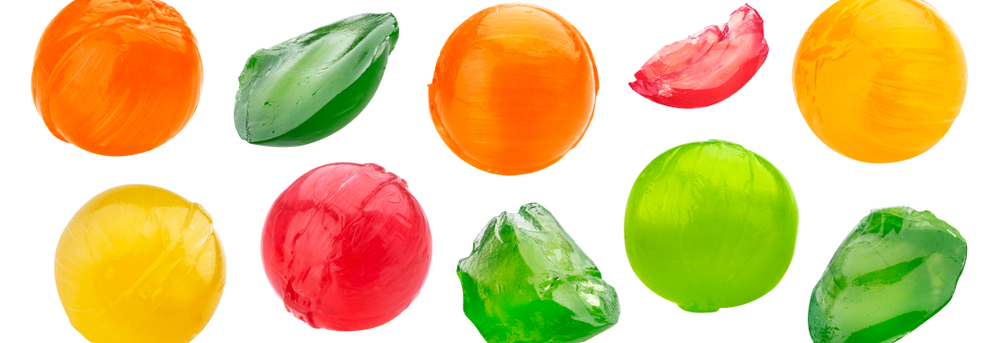Hard Candy History: Why These Sweets Will Always be Popular
| BY NEAL ROTHSTEIN

It’s hard to imagine a world without candy. Today there are thousands of candy products from all over the world, and one thing is for certain: people sure love their sweets! But where did candy originate from? How long have sugary confections been consumed by humans, and what is the history behind the hard candy we know and love today? While boiled sugar products are perhaps the first instance of the sweets as we’ve come to know in modern times, much of candy’s origins actually begins with the bumble bee.
Honey: nature’s natural sweetness was heavily-used in ancient Egypt
Ancient cave paintings from over 8,000 years ago depict humans collecting honey from wild bees. This may be the first evidence of humans attempting to satisfy their sweet tooth. Often, these prehistoric humans would get stung by the bees for invading their hive. But over time, beekeeping evolved.
The ancient Egyptians learned to blow smoke into the hive as they were extracting the bee’s sweet, sweet nectar. This technique was developed to distract the bees from stinging them, as the smoke masks the bee’s natural defenses, an alarm pheromone that alerts the rest of their hive when they sense a potential danger.

The history of the marshmallow:
As the ancient Egyptians evolved their practice of collecting honey for its natural sweetness, their recipes for how to use it evolved as well. Marshmallow was created in ancient Egypt over 2,000 years ago. This combined the honey with grains and the sap from the mallow plant which grows in marshes, hence the word: “marsh-mallow”. Unfortunately, only the Pharaohs, Gods and other members of nobility were allowed to eat this sweet treat at the time.
Sugar was first processed in India, leading the way to the first candy:
Ancient India had another plant with its own natural sweetness. Sugarcane is a tall, grass-like plant that grows well in tropical climates. Since it is a perennial, it can be harvested every 10-12 months without the need for replanting. It is likely that prehistoric humans would chew the stalk of this plant for the sweet taste, long before any historical texts existed. Once the Indians discovered that the sweet juice from this plant could be boiled-down into a solid, (creating brown sugar) the first kind of hard candy was born.
These early Indian civilizations are credited for creating the earliest forms of candy. The hard pieces left over after boiling-down a watery sugar solution was called khanda. This word is the etymological origin of the modern word “candy”.

Invaders and visitors to the land would be confused as to how these ancient Indians were able to produce “honey” without bees. In 510 A.D. Persian emperor, Darius discovered this “sweet salt” and began working with the Indians to export the brown sugar to other parts of the world. This secret recipe would make them rich for decades to come – that is until another invasion by the Arabs in 642 A.D. Once they got their hands on it, the product quickly spread to Europe and other civilizations across the globe.
Islamic writers in the early 9th century described the early production of rock candy that was made by sugar crystals forming from the cooling of a highly-saturated sugar solution. This would create rock candy sticks, that were perfect for adding sweetness to tea.
From this point in history, sugar never ceased to grow in popularity. By the early 1400’s Europeans had exported sugar cane to various parts of the world, including the Canary Islands off the coast of Africa, the West Indies and Brazil. Sugar had become a major commodity to be traded around the world at this point and more and more people began experimenting with how to use it.
The origins and history of hard candy
By the 1500’s the candy industry was born. In Europe candy makers were using a boiled granulated sugar solution to mix with fruits and nuts and these confections started to gain popularity among all classes in society. In the 1800’s hard candy had been created in England and the product was a hit with people in Colonial America.
Modern day industrialization paved the way for candy to become more mainstream. Industrial processes rapidly improved over time and the candy industry took advantage of the new machinery and production techniques. This was a huge step forward in making sweets more accessible to people from the working class.

Around the time after the American Civil War, companies also began marketing to children for the first time in history. Candy shops became commonplace in cities and towns across the globe and penny candy (mostly bulk hard candies) drove much of their sales.
The origins of the lollipop:
While the history of the lollipop is a long and fascinating one interesting tidbit is how a confectionary company in Connecticut, (the McAviney Candy Company) created their version of the lollipop, almost by accident! The employees would stir the hard candy solution as it cooked with wooden sticks at the factory. By the end of the day, these sticks would be covered in all sorts of random candy residues.
The company was nice enough to let their workers take these rock candy sticks home to their kids. The employees would come back the next day, explaining how their children loved them so much, the company saw a potential marketing gimmick. They began selling “candy sticks” to the public in 1908 and the rest is history!

Make your own rock candy crystals at home with this easy recipe!
Rock candy sticks are a fun and easy science project that your kids can do at home. The only difficult thing is that it requires a little bit of patience. You should have the common household items you will need to create this fun experiment laying around your house.
First, you’ll need:
-
4 12oz Mason jars, or one large quart-sized Mason jar. -
A clean piece of string or bamboo stick or skewer. -
A clothespin for each jar. -
2 cups of water. -
6 cups of granulated sugar. -
2-3 drops of food coloring (optional). -
Flavoring extract (also optional).
Begin by getting each wooden skewer or piece of string wet and rolling it around in granulated sugar. While these are drying, you can begin boiling the 2 cups of water in a medium-sized pan. Once the water boils, add one cup of sugar at a time, stirring until it has completely dissolved.
Once all of the sugar has been added and dissolved, remove the pan from heat and let the sugar solution cool for 20-30 minutes. Now is a good time to add any food color and flavoring you want to the mix.

Next, rinse out the mason jar with hot water, empty and add the sugar solution. Then, take your string or skewers and hang them about an inch from the bottom of each jar. Use a clothespin at the top of the jar to hold it in place. Cover with a paper towel or loose plastic wrap and store in a cool, dark place.
Now comes the hard part. You have to leave the jar in a place where it won’t be disturbed or jostled around. You should see the first crystals start to form within 2-4 hours. The longer you wait, the bigger the crystals will grow! But don’t let them get too big, otherwise the crystals forming might stick to the side of your jar. Once they reach their desired size, break the top layer of crystal with a fork and remove the stick from the jar. Let it dry for 1-2 hours and they’re ready to enjoy! If you’re saving them for later, you can wrap your rock candy sticks in plastic wrap until you’re ready to use them.
Once you’ve completed this fun confectionary experiment you will have made yourself, and your kids a part of candy history! We hope this fun recipe just might help inspire future generations of candy makers!






